Wednesday, September 27, 2006
Getting up the lady giant
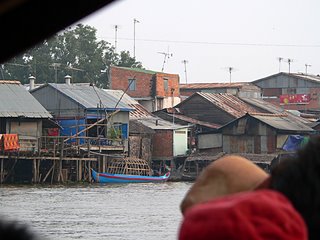
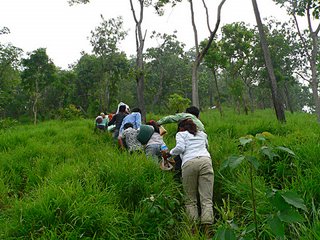
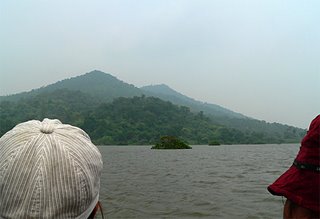 On the northern side of the Tonle Sap, opposite Kompong Chhnang, lies a small mountain range that perhaps resembles a reclining woman. There is a myth related to Phnom Kong Ray that tells how the female giant took the form of a human woman and married a man. I have received this story several times orally in bits and pieces. La has promised me a written translation. I'll share it with you when I get it. Please be patient.
On the northern side of the Tonle Sap, opposite Kompong Chhnang, lies a small mountain range that perhaps resembles a reclining woman. There is a myth related to Phnom Kong Ray that tells how the female giant took the form of a human woman and married a man. I have received this story several times orally in bits and pieces. La has promised me a written translation. I'll share it with you when I get it. Please be patient.When I arrived in Cambodia it was summer. We climbed a couple of mountains, or perhaps hills, on our side of the river. They asked if I would like to climb Phnom Kong Ray. I said I would. But they told me I had to wait until the rainy season. The mountain is a long way from the river in the dry season and difficult to reach. In the rainy season the river floods and it is possible to take a boat to the foot of the mountain or perhaps even a little of the way up it.
I had heard no more about this plan until last Saturday morning. I got a call from La. 'Do you want to climb Phnom Kong Ray tomorrow?'
'Well, I'd like to but I'm going to Phnom Penh tomorrow. Sorry.'
Later I thought about it and decided I shouldn't miss the opportunity. I rang La back and said I'd come. If you were hoping for some communication from me last weekend this is why you didn't get it. I have put off my Phnom Penh trip for a few days.
La picked me up on a motorcycle at 7 am. I had already prepared my lunch. The boat was waiting for us at Kompong Oz. Somehow I expected we would go down to the river but now the river is flooded and comes to us. There is no way of getting a boat into Kompong Oz in summer.
In typical Cambodian style the boat is very crowded. I found myself inside the small cabin which made it difficult to take photos. The first one here was taken close to the summer limit of the river. The stilts on these houses are maybe seven to ten metres high. On my flickr pages you can see some photos of houses just a little further along from here and there is very little water under them.
It didn't take us long to cross to where the other side of the river usually is. It took another half hour or 45 minutes to reach the mountain. We weren't the only ones there. There seemed to be some sort of celebration going on, perhaps for the end of P'chumbin.
Some of the gang needed to stop for breakfast and then we headed up the mountain. It wasn't a really difficult climb although it did get a little steep towards the end. It may be hard to see this in the second picture but that's why the group's all bunched together, the ones in the lead have slowed down. The pic does give a good representation of some of the terrain.
There are two peaks and we only went to the lower one. I would have been happy to go on but no one else was interested. We stopped there. I guess they thought that was a satisfactory achievement. Most people ate their lunch early. Cambodians usually eat lunch much earlier than I do. And before we started back down the Cambodians did the other thing that Cambodians usually do. They left their litter on the mountain top.
Going back was easier. But before we reached bottom I could hear it—the usual overloud speakers. Even here I could not escape them. At the bottom I sat with some of the monks and ate my lunch. There were about half a dozen kids dancing in front of the speakers. It really seemed overkill.
We hung around for a while and then set off for home. There were quite a few boats there. I guess they had all come from Kompong Chhnang. A few had come from Kompong Oz with our group. I asked if I could sit outside the cabin so I could get a few shots on the way back. They put me on an open boat instead. This wasn't such a good idea after all. There was a bit of chop on the water and as we motored into it there was quite a bit of spray. I got soaked. Fortunately I was able to protect my camera with a plastic bag and I did manage to get one or two shots in the calmer parts. The last one here is one of them. You can see the two peaks of the mountain and I'm sure you can recognize it's a lady giant. The island between us and the mountain range is not an island. It's the top of a tree. They're everywhere in this temporary lake.
More pictures from this trip can be found on my flickr pages. Enjoy.
Sunday, September 17, 2006
P'chum Ben festival
For a total of 15 days, we in Cambodia are currently celebrating the P'chum Ben festival. I ask what it is about and am told it is a time when people pray to their ancestors. My Lonely Planet Cambodia tells me that respects are paid to the dead through offerings of paper money, food and drink passed through the medium of the monks. (Cambodia only has paper money.) Perhaps it is a way to make donations to the monks and passing the merit onto the ancestors.
I am trying to make sense of all this without getting involved although I have been invited to speak at Wat Xam—I do not expect I will go.
When I was in Malaysia—not sure if it was this time of the year—the Chinese celebrated what Soon called the Hungry Ghost festival. For weeks before, many of the shops in town—I lived in Melaka's Chinatown—were full of paper replicas of houses, cars, money and people. These were to be burned to be used by the ancestors in heaven (or perhaps hell).
In my efforts to understand the Khmer people I have been reading one or two history books. They tell me that Cambodia is on the border of where the Indian and Chinese cultural influences meet in Asia. This doesn't entirely make sense to me. As China has Buddhism—which came from India. Yes, I understand that the Chinese are eclectic and have adapted Buddhism to fit with their earlier beliefs. This has also happened in the countries where Theravada Buddhism is practised, ie the ones with the 'Indian' influence, but perhaps staying more closely to the original Buddhism.
The books say that Cambodians have rejected Chinese influences which come to them via Vietnam. Cambodians are said to not like the Vietnamese. And I can confirm that this attitude is common. But somehow this practice of ancestor worship, which as far as I can tell is a Chinese concept, seems to be enthusiastically integrated into Cambodian Theravada Buddhism. In Thailand, another Theravada country, to my knowledge this Chinese practice exits only among the Chinese community. This suggests that it is not a Theravada practice and supports my theory that it has come to Cambodia from China via Vietnam.
I would observe that the ancestors being worshipped must have two qualities that I have become well aware of: 1. they are earlybirds and 2. they are deaf. I say this because the Cambodian version of this festival starts at 4 am every day for 15 days and is broadcast, as is the Cambodian habit, over large loudspeakers. It can be heard anywhere there is a wat. That's everywhere. And if there are two wats within hearing distance they compete with each other to gain the ancestors' attention. I think the only way to escape it is to leave the country. I have chosen to stay and use it as a challenge to retain my tranquility.
I have to qualify what I wrote in the previous paragraph. 'Everywhere' perhaps excludes Phnom Penh. My experience when staying overnight during two weekends of P'chum Ben is that from my guesthouse at 5 am (I guess I'm waking by habit now) I can hear nothing. Perhaps getting up at 4 am is a habit of people in the country, as country people in Australia are also earlybirds. City people are not such early risers.
Happy P'chum Ben. May your ancestors be blessed.
*****
I paid my second visit to the dentist and had the crown fitted. So far I am happy with the work that has been done. If anything goes wrong, I'll let you know.
I am trying to make sense of all this without getting involved although I have been invited to speak at Wat Xam—I do not expect I will go.
When I was in Malaysia—not sure if it was this time of the year—the Chinese celebrated what Soon called the Hungry Ghost festival. For weeks before, many of the shops in town—I lived in Melaka's Chinatown—were full of paper replicas of houses, cars, money and people. These were to be burned to be used by the ancestors in heaven (or perhaps hell).
In my efforts to understand the Khmer people I have been reading one or two history books. They tell me that Cambodia is on the border of where the Indian and Chinese cultural influences meet in Asia. This doesn't entirely make sense to me. As China has Buddhism—which came from India. Yes, I understand that the Chinese are eclectic and have adapted Buddhism to fit with their earlier beliefs. This has also happened in the countries where Theravada Buddhism is practised, ie the ones with the 'Indian' influence, but perhaps staying more closely to the original Buddhism.
The books say that Cambodians have rejected Chinese influences which come to them via Vietnam. Cambodians are said to not like the Vietnamese. And I can confirm that this attitude is common. But somehow this practice of ancestor worship, which as far as I can tell is a Chinese concept, seems to be enthusiastically integrated into Cambodian Theravada Buddhism. In Thailand, another Theravada country, to my knowledge this Chinese practice exits only among the Chinese community. This suggests that it is not a Theravada practice and supports my theory that it has come to Cambodia from China via Vietnam.
I would observe that the ancestors being worshipped must have two qualities that I have become well aware of: 1. they are earlybirds and 2. they are deaf. I say this because the Cambodian version of this festival starts at 4 am every day for 15 days and is broadcast, as is the Cambodian habit, over large loudspeakers. It can be heard anywhere there is a wat. That's everywhere. And if there are two wats within hearing distance they compete with each other to gain the ancestors' attention. I think the only way to escape it is to leave the country. I have chosen to stay and use it as a challenge to retain my tranquility.
I have to qualify what I wrote in the previous paragraph. 'Everywhere' perhaps excludes Phnom Penh. My experience when staying overnight during two weekends of P'chum Ben is that from my guesthouse at 5 am (I guess I'm waking by habit now) I can hear nothing. Perhaps getting up at 4 am is a habit of people in the country, as country people in Australia are also earlybirds. City people are not such early risers.
Happy P'chum Ben. May your ancestors be blessed.
*****
I paid my second visit to the dentist and had the crown fitted. So far I am happy with the work that has been done. If anything goes wrong, I'll let you know.
Saturday, September 16, 2006
Popular huntsman
 Most people who read this blog will be aware that I also have four flickr photo pages. A friend once expressed surprise that I had four flickr pages. 'How do you get four?' he asked.
Most people who read this blog will be aware that I also have four flickr photo pages. A friend once expressed surprise that I had four flickr pages. 'How do you get four?' he asked.It's easy. You just need four different email addresses. The alternative is to have one page and pay $US25 per year for a flickr pro account which allows you to upload unlimited photos. In fact, I could probably afford to pay that but I have this perception of myself as living frugally in a developing country and it seems there are more important things to spend my limited budget on than a flickr pro account.
In any case, that's the way I've gone. Each page has a theme. The main one is for general pics; then there's one for exotic transport (I see plenty of that in Asia); one for flowers and plants; and one for wild things.
The photos are there for the same reason as my blog—to share with family and friends. However, they do attract many visits from strangers. The wild things page is particularly popular. Perhaps this is because I have a knack of getting up close to creatures that some people like to keep at a distance.
Generally my photos are viewed between 10 and 20 times. Some more interesting ones reach over 50 views and one or two are in the hundreds. I was quite surprised recently to discover that one of my photos had been viewed over 3,000 times.
I have to wonder just who all these viewers are. I suspect someone with a related website has linked my picture to their site. The popular picture is not of some exotic creature from Asia. It is found in most Australian homes, and I'm told is found in most countries around the world. It's the huntsman spider you see here. I photographed it in my mother's house in Brisbane.
If you are not familiar with my flickr pages, you can find them by following the appropriate links on the sidebar.
Monday, September 11, 2006
Living like Steve
Since I moved into my house I rarely watch TV. However, two friends emailed me with news of the death of Steve Irwin. Teaching English in a non-English-speaking country I become quite aware of the English that I use. When I would occasionally watch Steve on Discovery Channel I would think that he speaks real 'Australian'. If my students asked me about Australian language I would tell them to watch Steve but the response would come back: Discovery Channel? Cable TV? It is completely outside their world.
The other thing I used to think when I watched Steve was that he is a risk taker. I don't think it is sad that he died. He lived an amazing life. Most of us don't get to have a small percentage of the adventures he lived almost every day. He achieved much in his short life. He knew he was taking risks. He knew that this could kill him one day but he didn't let that stop him from living. How many people can say that? Those who are alive but afraid to live are much sadder than the dead Steve.
*****
I was flossing my teeth a few nights ago and a piece of filling came out. So now what do I do, I wondered.
The next time I ate it became obvious that I needed to get it replaced. The gap was holding food in a major way and I figured it would only lead to more decay.
Sarun's advice was to go to the lower market. There are dentists there who only charge $5 a tooth. In Phnom Penh, he told me, they charge almost $100.
Now there are times when it is good to economize and times when it's not. I think dentistry is one of the latter. I tossed up on waiting until I got to Thailand. But my friend Ursula had a crown replaced when she was in Phnom Penh and her report was positive.
Only I didn't know where to find her dentist.
I decided to stay overnight in Phnom Penh on my weekly visit. I went on Sunday so that I could visit the dentist on the Monday morning. But as I walked around on Sunday afternoon I noticed that there were several dentists open. There are several rather up-market ones in the Sorya area that look like they might charge close to $100. I don't think that is where Ursula went.
I was also having difficulty deciding where to stay. The place I usually stay is in the Sorya area but last time I went there the room had a strange smell about it. I decided to go to the place I first went to when I came here last year, the International Guesthouse.
It is a bit of a walk from Sorya but the walk took me past a few dentists. Some looked a bit grubby but there were a couple that looked OK and were open. After I got my room I went back.
I was taken in and treated immediately. He was quite professional. The equipment and procedures were much as I am used to in Australia and so far I have no complaints.
One tooth has been filled. There was a crack in the filling. And he will put a ceramic crown on the one where the gap is. He took an x-ray to make sure that would be possible. I go back this morning for the mould to be made for the crown. And the cost? The filling, $10; the ceramic crown, $100; and the x-ray, $2. (prices are $US)
The other thing I used to think when I watched Steve was that he is a risk taker. I don't think it is sad that he died. He lived an amazing life. Most of us don't get to have a small percentage of the adventures he lived almost every day. He achieved much in his short life. He knew he was taking risks. He knew that this could kill him one day but he didn't let that stop him from living. How many people can say that? Those who are alive but afraid to live are much sadder than the dead Steve.
*****
I was flossing my teeth a few nights ago and a piece of filling came out. So now what do I do, I wondered.
The next time I ate it became obvious that I needed to get it replaced. The gap was holding food in a major way and I figured it would only lead to more decay.
Sarun's advice was to go to the lower market. There are dentists there who only charge $5 a tooth. In Phnom Penh, he told me, they charge almost $100.
Now there are times when it is good to economize and times when it's not. I think dentistry is one of the latter. I tossed up on waiting until I got to Thailand. But my friend Ursula had a crown replaced when she was in Phnom Penh and her report was positive.
Only I didn't know where to find her dentist.
I decided to stay overnight in Phnom Penh on my weekly visit. I went on Sunday so that I could visit the dentist on the Monday morning. But as I walked around on Sunday afternoon I noticed that there were several dentists open. There are several rather up-market ones in the Sorya area that look like they might charge close to $100. I don't think that is where Ursula went.
I was also having difficulty deciding where to stay. The place I usually stay is in the Sorya area but last time I went there the room had a strange smell about it. I decided to go to the place I first went to when I came here last year, the International Guesthouse.
It is a bit of a walk from Sorya but the walk took me past a few dentists. Some looked a bit grubby but there were a couple that looked OK and were open. After I got my room I went back.
I was taken in and treated immediately. He was quite professional. The equipment and procedures were much as I am used to in Australia and so far I have no complaints.
One tooth has been filled. There was a crack in the filling. And he will put a ceramic crown on the one where the gap is. He took an x-ray to make sure that would be possible. I go back this morning for the mould to be made for the crown. And the cost? The filling, $10; the ceramic crown, $100; and the x-ray, $2. (prices are $US)
Sunday, September 10, 2006
Who do you admire
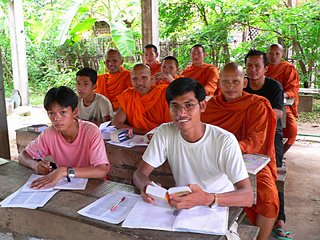 Here is one of the classes I teach under my house. As you can see, this class is 100% male and predominantly monks. There are a couple of teenage girls who come to one of the other classes but I certainly find my classes now attract more young men. When I was teaching at Wat Xam I found the male students were more serious about their studies. Not sure if that is why it is happening this way here.
Here is one of the classes I teach under my house. As you can see, this class is 100% male and predominantly monks. There are a couple of teenage girls who come to one of the other classes but I certainly find my classes now attract more young men. When I was teaching at Wat Xam I found the male students were more serious about their studies. Not sure if that is why it is happening this way here.I taught one or two of these students at Wat Xam but the monks here come from monasteries that are closer to my home.
I asked these guys to start the lesson by introducing themselves and naming someone they admired. Most named local figures—the prime minister, the leader of the opposition, the ex king, Cambodia's head monk. One named Taksin Shinawatra, the Thai Prime Minister, who might not be quite so popular in his own country at the moment. Only one named a woman, Princess Diana. The only other international names I can recall were George Washington and the Dalai Lama.
These students are quite keen and we have an enjoyable hour together each week discussing articles on subjects that might have something to offer them apart from English language.
Monday, September 04, 2006
Khmer cakes & communication
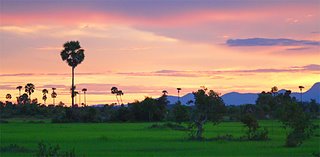 Regular readers of this blog may remember that at Khmer New Year and earlier, La had taken me to visit his village about 11 km out of town. The first time we stayed in the house of La's cousin.
Regular readers of this blog may remember that at Khmer New Year and earlier, La had taken me to visit his village about 11 km out of town. The first time we stayed in the house of La's cousin.Since then the cousin's niece, Seinee, who lives next door to her, became my student. Seinee would often ask, 'My family want to know when you will come to visit again.'
I was unable to accept the invitation prior to rearranging my schedule. This weekend I accepted the offer.
It was my choice to go without La because I wanted to communicate directly with these people. I rode out Saturday morning by myself. It took me about an hour and a quarter to get there. No hassles.
When I arrived I rode into Sienee's yard and was greeted by her family. After a while she took me to visit another house in the row (The row is all family.) where they were popping rice like popcorn in a big wok over an open fire. Some of this was being eaten directly and some was being pounded to be made into flour for making Khmer 'cakes'. The cakes were quite simple. They got some palm sugar, which is liquid, and boiled it to reduce it to a syrup (or more like treacle). When that was thick enough they mixed in the popped rice flour and moulded it into rough egg shapes. When these cooled they were ready for eating—Khmer cakes.
While we were eating the cakes, Seinee said that her aunt had asked why I hadn't come with La and Sokun. I said I was happy to come alone. She said that her aunt wants to talk with me and needs La to translate. I said that I thought that she (Seinee) was doing a good job and that it was helping her to practise English. But they didn't accept that. Next they're on the phone to Sokun and La. The upshot was that La ended up staying overnight with us and what happened? Well, communication between me and the aunt ceased. Perhaps she was asking La questions and he was answering on my behalf but he was not referring the questions to me. It was a two-way, not three-way conversation.
Anyway, while the rest of them were busy La did take me for a walk a couple of times. The rice fields are currently a beautiful range of greens—just beautiful. And in the late afternoon I was able to get some lovely sunset shots.
Sunday morning Sienee came into town to visit her grandparents. So I had her company on the return journey. She said to me, 'My aunt wants to know when you will come back again.'
'When I can speak Khmer a little better,' I answered,
*****
And, as you probably know I'm working on it.
I have spent a lot of time this week recording both Vanna and Pierot reading dialogs and monologs for me in Khmer. This is stuff that I want to learn. I am now working from two text books. But they say, for example, 'I come from France' and I want it to say 'I come from Australia' and other stuff that's relevant to me.
Actual progress in learning has been slow this week but I now have a lot up my sleeve for practising in the future. I still have a bit more to record and in due course there will be more still but I expect this will keep me busy for a while.